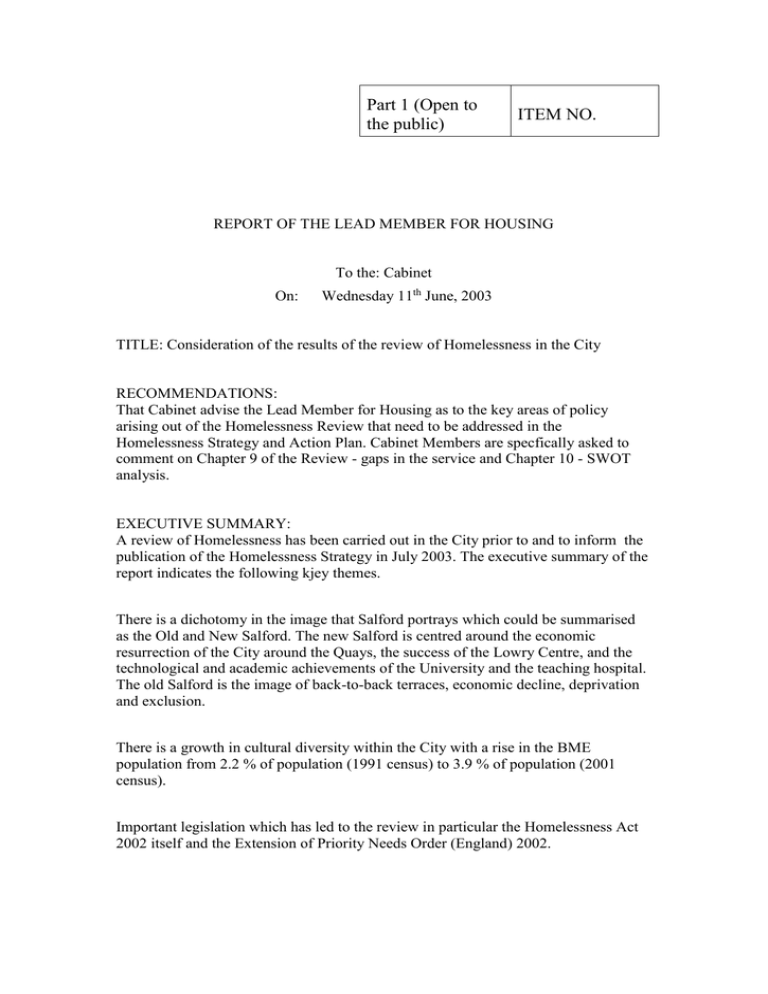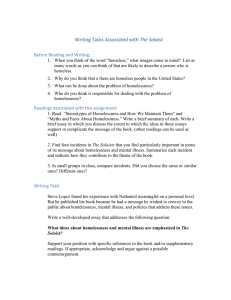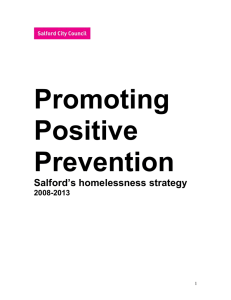Part 1 (Open to ITEM NO. the public)
advertisement

Part 1 (Open to the public) ITEM NO. REPORT OF THE LEAD MEMBER FOR HOUSING To the: Cabinet On: Wednesday 11th June, 2003 TITLE: Consideration of the results of the review of Homelessness in the City RECOMMENDATIONS: That Cabinet advise the Lead Member for Housing as to the key areas of policy arising out of the Homelessness Review that need to be addressed in the Homelessness Strategy and Action Plan. Cabinet Members are specfically asked to comment on Chapter 9 of the Review - gaps in the service and Chapter 10 - SWOT analysis. EXECUTIVE SUMMARY: A review of Homelessness has been carried out in the City prior to and to inform the publication of the Homelessness Strategy in July 2003. The executive summary of the report indicates the following kjey themes. There is a dichotomy in the image that Salford portrays which could be summarised as the Old and New Salford. The new Salford is centred around the economic resurrection of the City around the Quays, the success of the Lowry Centre, and the technological and academic achievements of the University and the teaching hospital. The old Salford is the image of back-to-back terraces, economic decline, deprivation and exclusion. There is a growth in cultural diversity within the City with a rise in the BME population from 2.2 % of population (1991 census) to 3.9 % of population (2001 census). Important legislation which has led to the review in particular the Homelessness Act 2002 itself and the Extension of Priority Needs Order (England) 2002. There is a general trend upwards in homeless presentations year on year across all the priority needs groups. The main groups presenting as homeless and to whom the Local Authority owe a duty are, families, pregnant households, 16/17 year olds, and those suffering domestic violence. There is a significant increase in those in priority need due to mental illness. A significant proportion of families presenting are lone one-parent households, a significant deprivation and social exclusion indicator. The main routes into homelessness in the City are: Family and relationship breakdown remains a major factor, with a high rate of presentations for those homeless due to the violent breakdown of relationships; Refugee (ex- Asylum Seeker) presentations have increased; there is also an increase in those losing Assured Shorthold tenancies. The strategy will need to address these rises in presentation through effective preventative measures using Housing Advice and Support Services. There are a range of influencing factors to predict future trends in homelessness. Economic, legislative, social landlords policy and procedures, private landlords, social factors, health, probation, national policy, local housing market demand and hidden homelessness. All the factors have been assessed as having a negative impact on those facing the loss of their home in the City. This raises serious capacity issues for the future service. The anticipated increases in homelessness must be addressed by prevention and sustainment measures, by the recognition of the impact that some policies have on homelessness and a willingness to address homelessness as a serious and relevant issue in the City. The review has shown that Salford has a good range of temporary accommodation provision, however the accommodation is not necessarily of the right type or in the right location for the different client groups. In some there is an overlap of provision and in others a gap in provision. These issues will be addressed by the Supporting People Team as part of the National quality assessment framework. The Homeless Service has a good track record of inter –agency working and strong links with homeless accommodation providers within the City. The Service is weak however in the area of consultation with homeless service users. This is in part due to the difficulty in consulting with a highly mobile, difficult to reach client group, and partly due to a lack of resources in this area in the past. Salford has a very good range of Services already developed around the homelessness and homeless prevention agenda. The centralised Homelessness and Housing Advice Team, Supported Tenancies Team, Asylum Seeker Team were all expanded as Services under the Supporting People Agenda in advance of the homeless strategy. However with the Arms Length Management Company formation Social Housing Services have been split into 2 different organisations, this makes the seemless provision of housing and support services more difficult. A relatively new issue for the City since 2000 has been its participation in the dispersal of Asylum Seekers under contract with Central Government. A growing number of Asylum Seekers who have been given leave to remain in the Country (refugees) are choosing to make their homes in the City, due to the unique nature of their previous stay in the country detailed in chapter 7 there is a need for additional support to ensure refugees have the same access to services as other homeless people in the community. The review analyses the gaps in service at present overlaps that exist. Many of the gaps identified can be addressed relatively easily through the Homeless Strategy Action Plan, however the difficult gap to overcome will be of awareness within the whole community regarding the existence and relevance of the service and to overcome the perception that homelessness is a public sector problem with a public sector solution. BACKGROUND DOCUMENTS: ASSESSMENT OF RISK: THE SOURCE OF FUNDING IS: LEGAL ADVICE OBTAINED: FINANCIAL ADVICE OBTAINED: CONTACT OFFICER: WARD(S) TO WHICH REPORT RELATES: ALL WARDS KEY COUNCIL POLICIES: Equalities; Health; Housing Strategy; Social Exclusion; DETAILS:






